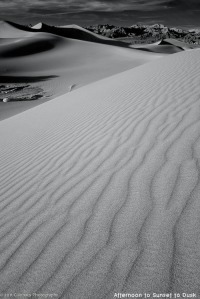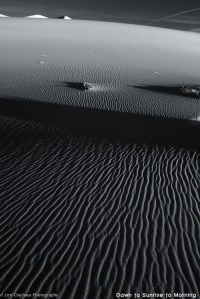There is something poetic, majestic, romantic and sensuous about sand dunes. I’m not talking about those scrubby little things dotted with dried-out fast food wrappers and sun-bleached soda bottles that you can find along most stretches of public beach. But rather, the isolated and austere, expansive and sometimes towering stretches of dunes that entice you to wander into their curving and hidden folds, that seduce you to continue venturing deeper, searching for the most glorious view, the untouched ripples, the perfect feminine roll of land meeting sky.?? These are the dunes of mystery and power that figure in Lawrence of Arabia, Edward Weston’s visions of Oceano, Wilfred Thesiger’s wandering through the Rub’ al Khalil, and Frank Herbert’s detailed and developed world of Arrakis.
In the large swath of desert and mountains that comprise Death Valley National Park there are a number of areas were dunes reside, if not reign.?? Saline Valley’s dunes are low but seldom visited.?? Panamint Valley features a relatively small set of dunes sitting forlorn, almost forgotten in the northern, unvisited end of the valley.?? Eureka Valley, isolated at the tail end of 45 miles of washboard road, boasts the highest dunes in the Great Basin, towering over 650 feet above the floor. Death Valley proper hosts the most popular dunes in the park. Located in the Mesquite Flat area just outside Stovepipe Wells, these are the dunes I visited this past April.
Rolling into the campground late in the afternoon the first week of April, the temperature hovered around 101??F. Stovepipe Wells really is the most pathetic excuse for a campground.?? It is essentially one large gravel parking lot for the RVers bounded on the north side by 20 or so anemic looking campsites for those that still pitch a tent.?? The only saving grace was the hummocky mesquite bush-topped, miniature dunes that I was able to set my tent behind in order to gain at least some privacy.?? Duty done, it was time to head to the dunes, located just a mile distant.
There really are two good times of the day for photographers to hang out on the dunes: dusk and dawn.???? (A case could be made for a moon and star drenched evening with some long exposure work… as long as you can find your way back to your vehicle/campsite.)?? Late afternoon was hot but we wandered quite a-ways out on the dunes, looking both for relatively untracked sand and the perfect place to catch the glow of sunset.
The Mesquite Sand Dunes feature one obvious high dune that acts as both a centerpiece and magnet for photographers and tourists alike.?? So, my goal became to position myself to have the central high dune clearly in the majority of compositions.?? I ascended one final ridge, exhausted after 9+ hours of driving, setting up camp and finally trudging through the hot sand and hotter air, and with the big dune in front of me, declared a victory of sorts by planting my tripod.
As the shadows grew, the sand began a transformation to gold and the faint wispy strands of cloud shifted to coral-pink. This was the time to shoot. Which, I did – see below. (My shooting partner captured just about the perfect late afternoon dune shot here.)
For me, this is very much ultra wide-angle country.?? I want to capture the ripples of sand inches from my feet and the blackened mountains on the distant horizon…and all must be sharp.?? So, I stop down close to or at the limit of the lens I have mounted.?? Can I do that AND have the image sharp throughout the frame? Not always, but often.?? It is a trade-off, but compromise is usually part of the equation in photography.??
The next morning we were up before dawn and again trudged our way over the dunes.?? It was much cooler though and we were refreshed so the walk was pleasant rather than a “death march.”?? We deliberately hiked further out into the dunes to avoid the bulk of the human tracks.?? I eventually positioned myself above a sweep of virgin ripples and waited for the sun to rise. When it did, it provided intense side lighting and the sand ripples became topographically pronounced: perfect compositional fodder for my infrared cameras.?? I found myself laying on the dunes trying to get as low an angle as possible to capture the details and relief of the sand.?? I needed to shoot fast though as the landscape and shadows were changing rapidly.
Morning on the dunes is also a great time to look for tracks left by the various nocturnal creatures that wander at night.?? Beetle and small animal tracks were scattered here and there, but the highlight was when I found a sidewinder track and followed it for a 100 meters or so up and over the sharp crest of a dune.
By 9am we were pretty close to being finished shooting on the dunes.?? The light was turning quite harsh, though I was still getting some good images with my infrared cameras.?? (Infrared loves the strong contrast of mid-day and as long as you can maintain shadow detail and not blow out the sky, you can capture striking images.)?? It was time to move on other Death Valley treats and the sky promised another over 100?? day…not really a time to be wandering the giant sand trap of Death Valley Sand Dunes.
We enjoyed our sunset and sunrise on the Mesquite Flat Sand Dunes and captured a number of strong images, but I was already thinking about other ways to capture the forms, light and emotions of this austere but beautiful landscape. I was also thinking back twenty-plus years ago when I first rattled up to the towering Eureka Sand Dunes.?? What I could do photographically with those dunes today!?? It would have to wait though as other locations, Racetrack Valley included, were on our agenda this trip.?? However, the promise was made: Eureka or bust next Spring!








No comments:
Post a Comment
Note: Only a member of this blog may post a comment.